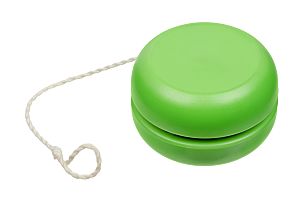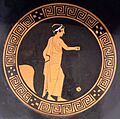Yo-yo facts for kids
A yo-yo is a classic toy made of two discs connected by an axle, with a long string wrapped around it. It's a toy that has been around for a very long time, with evidence of it existing as far back as 440 BC.
To play with a yo-yo, you hold the end of the string, usually by putting a finger through a slip knot. You let the yo-yo drop, and gravity makes it spin as the string unwinds. Then, with a flick of your wrist, you can make the yo-yo use its spinning energy to climb back up the string to your hand. This is called "yo-yoing."
One of the most basic tricks is the sleeper. This is when the yo-yo spins at the end of the string for a while before you call it back. Mastering the sleeper is the first step to learning many other cool tricks.
Contents
The Long History of the Yo-Yo
The yo-yo is not a new invention. Toys that look just like yo-yos were played with by the Ancient Greeks. Pictures on old Greek vases show people playing with them. These ancient toys were made of wood, metal, or painted clay. When a child grew up, they would sometimes offer their clay yo-yo to the gods as a symbol of leaving childhood behind.
In the 1700s, a similar toy was popular in England, where it was called a bandalore. The word "yo-yo" is thought to come from the Ilocano language of the Philippines.
The First Yo-Yo Company
In 1928, a Filipino immigrant in the United States named Pedro Flores started the Yo-yo Manufacturing Company. He began by making just a few dozen yo-yos by hand. But by the next year, his company was making 300,000 yo-yos every day!
Flores's yo-yos had a special feature that changed everything. In older yo-yos, the string was tied tightly to the axle. This meant the yo-yo could only go up and down. Flores used a looped string that wasn't tied tightly. This small change allowed the yo-yo to "sleep" at the end of the string, opening the door for all kinds of new tricks.
Soon, a businessman named Donald F. Duncan saw how popular the toy was becoming. He bought Flores's company in 1932 and started the Duncan Toys Company, which made the yo-yo famous across the world. The Duncan yo-yo was so iconic that it was added to the National Toy Hall of Fame in 1999.
How Yo-Yos Evolved
After World War II, yo-yo sales went down. To bring them back, the Duncan company started a big TV advertising campaign in 1962, making yo-yos popular again.
A huge change in yo-yo technology came in the 1980s and 90s with the invention of the ball-bearing yo-yo. A ball bearing is a set of small steel balls that let the axle spin with very little friction. This was a game-changer!
Yo-yos with ball bearings could spin for much, much longer than older models. This allowed players to invent longer and more complicated tricks that were impossible before. Today, most advanced yo-yos use ball bearings, some made from special materials like ceramic to reduce friction even more.
Modern Yo-Yo Tricks and Styles
Thanks to ball bearings, modern yo-yoing is full of amazing and complex tricks. Players can now do things that were once unimaginable. This has led to different styles of yo-yo play, each with its own set of tricks and competitions.
Many yo-yo players share videos of their tricks online, especially on social media sites like Instagram and TikTok. There are even official competitions like the World Yo-Yo Contest where the best players show off their skills.
Basic Techniques
- Sleeping: This is the foundation for most string tricks. You throw the yo-yo down hard, and it spins at the end of the string. While it's sleeping, you can do tricks like "Walk the Dog" or "Rock the Baby."
- Binding: Modern "unresponsive" yo-yos don't come back with a simple tug. You have to perform a trick called a "bind," which involves looping the string in a special way to make the yo-yo catch and return to your hand.
Styles of Play
Yo-yo competitions are often divided into different styles, or divisions:
- 1A (Unresponsive): This is the most common style. It uses one unresponsive yo-yo to perform long and complex string tricks.
- 2A (Looping): This style uses two responsive yo-yos at the same time, one in each hand. The player performs looping tricks, keeping both yo-yos in constant motion.
- 3A (Two-Handed String Tricks): This difficult style involves doing string tricks with two unresponsive yo-yos at once.
- 4A (Off-string): In this style, the string is not attached to the yo-yo. The player throws the yo-yo into the air and catches it on the string to perform tricks.
- 5A (Freehand): For this style, the string isn't tied to your finger. Instead, it's attached to a small counterweight. The player performs tricks by manipulating both the yo-yo and the counterweight.
How Does a Yo-Yo Work?
When you throw a yo-yo, you give it energy. As it falls, the unwinding string makes it spin very fast. This spinning motion is key to how a yo-yo works.
The spinning creates rotational energy, which keeps the yo-yo stable at the end of the string, allowing it to "sleep." When you want it to come back, you give the string a little tug. This tug creates friction, causing the string to catch on the axle and wind itself back up, returning the yo-yo to your hand.
For an unresponsive yo-yo, a simple tug isn't enough. The gap between the discs is wider, so you need to do a "bind" to create enough friction for the string to catch and wind up.
Were Yo-Yos Ever Used as Weapons?
You might see yo-yos used as weapons in cartoons or video games, but there is no real evidence that this ever happened in history. The idea that yo-yos were weapons in the ancient Philippines was likely a marketing story created to make the toy sound more exciting. It's a fun idea, but it's just a myth.
See also
 In Spanish: Yo-yo para niños
In Spanish: Yo-yo para niños
- Chinese yo-yo
- Clackers
- Eskimo yo-yo
- Kendama
- Top
- Yo-yo balloon









